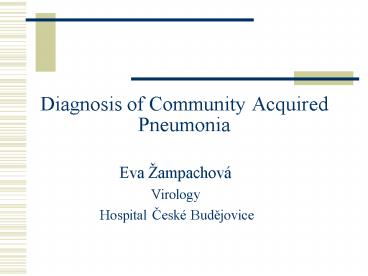Diagnosis of Community Acquired Pneumonia - PowerPoint PPT Presentation
1 / 21
Title:
Diagnosis of Community Acquired Pneumonia
Description:
... expectoration (purulent), high level of CRP, typical clinical findings and X-ray ' ... none, low to moderate CRP level, unspecific clinical findings, X-ray ... – PowerPoint PPT presentation
Number of Views:615
Avg rating:3.0/5.0
Title: Diagnosis of Community Acquired Pneumonia
1
Diagnosis of Community Acquired Pneumonia
- Eva ampachová
- Virology
- Hospital Ceské Budejovice
2
Characteristic symptoms of CAP
- Bacterial
- acute onset, high fever, cough with expectoration
(purulent), high level of CRP, typical clinical
findings and X-ray - Atypical
- slower onset, fever (often without cough),
expectoration scarce or none, low to moderate CRP
level, unspecific clinical findings, X-ray
reveals pneumonia
3
Community Acquired Pneumonia (CAP)
- Bacterial
- Pneumococcus, Haemophillus, Moraxella, Gram
negative rods, others - Atypical
- Mycoplasma, Chlamydia, Legionella, viruses
4
Agents causing atypical pneumonia
- Mycoplasma pneumoniae
- Chlamydia pneumoniae
- Legionella sp.
- Viruses
5
Mycoplasma pneumoniae
- Outbreaks every 4-5 years
- Sporadic cases can be detected
- Predominantly in children and young adults
6
Diagnostic of Mycoplasma pneumoniae
- Direct detection of microorganism
- Culture
- Antigen detection
- DNA detection (PCR)
- Antibody detection
7
Direct detection of microrganism
- Culture
- Slow, less sensitive
- Antigen detection
- Not widely used, less sensitive
- DNA detection (PCR)
- Promising
- The main problem is a valid sample
8
Antibody detection
- Complement binding reaction (CBR)
- Fourfold increase of antibody titre
- Best sensitivity and specificity
- Enzyme immunoassay (EIA)
- IgG, IgA, IgM classes
- Differences in results depending on manufacturer
of a test
9
Comparison of EIA tests
- Five kits from different manufacturers
- All sera tested in IgG, IgA, IgM classes
- Panel of CBR seroconversion and CBR negative
sera
10
Results
- Sensitivity
- IgA 68-97, IgM 87-97
- Specificity
- IgA 76-100, IgM 60-99
- PPV
- IgA 91-99, IgM 90-99
- NPV
- IgA 50-90, IgM 78-91
11
Pitfalls in EIA testing
- High sensitivity was combined with low
specificity and vice versa - No manufacturer had excelent quality of tests for
both IgA and IgM - Correct diagnosis from the first sample could be
done in approx. 40 of cases,
12
Conclusion (Mycoplasma)
- It is essential to choose carefully not only
manufacturer but also the test used. - No approach is free of charge. You pay for high
sensitivity with low specificity - First sample testing leads to diagnosis in 40 of
cases
13
Chlamydia pneumoniae
- Occurs more frequently in older patients, can
cause complications in patients with other
diseases - Outbreaks occur locally, with no typical
periodicity - Most cases are sporadic
14
Diagnostic of Chlamydia pneumoniae
- Direct detection of microorganism
- Culture
- Antigen detection
- DNA detection
- Detecton of antibodies
15
Direct detection of microorganism
- Culture
- difficult
- Antigen detection
- low sensitivity and specificity
- DNA detection
- Promising
- The main problem is valid sample
16
Antibody testing
- EIA
- Mostly genus specific, less sensitive in early
stage of infection, Ab detected long time after
resolution of the disease - Imunofluorescent test (MIF)
- golden standard, time and labour-consuming
- Immunoblott
- Confirmaton method
17
Immunoblott results in detection of acute
infection
- Panel of 43 sera from patients with clinical and
microbiological markers of acute Chlamydia
pneumoniae infection - Concordant results (MIF and IB) 63
- Negative or borderline IgA in IB 21
- IB negative, MIF positive 16
- Results of reconvalescent blood sample proved the
diagnosis - Infants with C. trachomatis respiratory tract
infection (6) 100
18
Immunoblott in detection of chronic Chlamydia
infection
- Tested on panel of 80 sera with several month
persistence of IgG and IgA MIF antibodies to
Chlamydia pneumoniae - IB positive IgG and IgA 31
- IB positive IgG only 51
- IB negative 18
19
Antibodies are not disease. To treat antibody
levels without corresponding illness is a serious
mistake. It leads to impropper use of antibiotics
and it is one of the causes of increasing ATB
resistance.
20
Conclusion (Chlamydia)
- IB is a confirmatory method
- IB is less sensitive than MIF (can be negative in
early phases of acute infection) - Interpretation of the results should be based on
laboratory and clinical data and on patients
history - So caled persistent infection is diagnostic
problem. Only long term survey of patient and
repeated testing may help
21
Conclusions
- Diagnosis of Chlamydia pneumoniae and Mycoplasma
pneumoniae is based mainly on antibody testing - Culture and PCR have their limits (valid sample)
- Carefull choice of tests and interpretation of
the results with reasonable knowledge of clinical
data seems to be essential - Without interpretation the results might be
misleading































